By David Kermani
Illustrated by Ahndraya Parlato
I. Memory (and Time)
Memory is acknowledged to be an important aspect of John Ashbery’s poetry. Memories, the way memory functions, and the ways in which we use both actual memory and the process of remembering to shape our lives, all are animating forces of Ashbery’s written poetic constructions. Similarly, memory and memories, with all their mutabilities through time, are powerful factors operating in Ashbery’s Created Spaces, and indeed (I believe) influenced his selection of the two very different spaces which are the settings of his most ambitious artistic creations—the spaces in which he lives and works. At a conceptual level, this is equivalent to selecting a poetic form at the start of the writing process: a sestina, a pantoum, a sonnet, blank or free verse, each very different and allowing for drastically different possibilities.
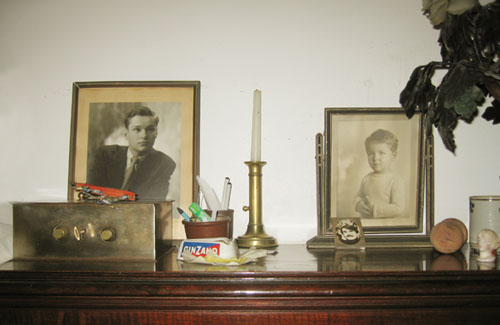
Chelsea: Memory and memories, with all their mutabilitites. Bedroom. Photo by Ahndraya Parlato.
Ashbery himself has often said that his house in Hudson reminds him in many ways of his grandparents’ home in Rochester, where he spent much of the happiest time of his early childhood. However, it took me a long time to realize just how similar both houses really are. While they do not look particularly alike, the two date from the same period (the 1890s) and are built in the same general architectural style (Queen Anne/Colonial Revival). They share a basic vocabulary of materials (smooth-faced brick, rough-hewn stone, clapboard, etc.) and design elements (masonry piers on either side of the front steps, deep front porches with simple columns, shutters, large single-pane double-hung windows on the two main floors, with small ornamental-paned glass in the Palladian window in the attic gable), and to some extent an interior layout (a large, open staircase turning at a central landing, on which Ashbery used to play and look down into the first floor spaces; the back stair to the kitchen and its butler’s pantry; the upstairs rooms opening onto the central stair hall; etc.). These similarities evoke strong memories of Ashbery’s childhood experience (rather than a specific physical reality), and although the Hudson house is designed to appear more monumental and impressive than his grandparents’, it is precisely due to that grander scale that it can trigger in the adult Ashbery feelings that the more modest house produced in the small child (and consider also how it compared with the simplicity and overall horizontality of the family’s farmhouse in Sodus, which are echoed in the New York apartment).
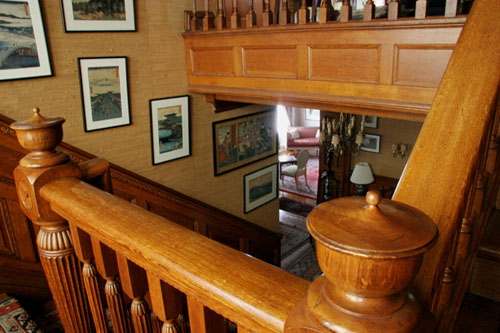
Hudson: The landing of the stairs in Ashbery's home resembles that of his grandfather's house, where he used to play and peer down. Main staircase. Photo by Ahndraya Parlato.
In addition, Ashbery’s interest in houses of this period may well reflect his childhood situation in more abstract but nonetheless important ways. The Rochester and Hudson houses were technologically advanced for their time, incorporating the latest modern conveniences such as central heating (fireplaces had become merely decorative, the psychological heart of the room), indoor plumbing, dual-powered gas, and electric lights (the reliability of the latter was questionable). Ashbery’s grandfather, Henry Lawrence, was a scientist involved with the new field of physics, particularly with what we now know as x-rays—imaging technology, just like his friend and neighbor George Eastman who, in addition to everything else, was instrumental in the development of the commercial film industry (i.e. “Hollywood”) as we know it. These households were traditional in many ways, yet filled with the excitement of advanced scientific research and discovery (see Section II, below).
Perhaps surprisingly, the idea of memory is not absent from Ashbery’s New York City apartment either. I knew that this was the first “modern” place he had lived in; he has spoken of the attraction of living in a building with such conveniences as elevators and a resident superintendent. So, when obliged to move in 1972, he took an apartment in a bland 1960s high-rise, liking it so much that he rented a larger and better-situated apartment in the same building when the first lease expired in 1974, and then in 1984 he moved into a still larger space on a higher floor, in what he considers the best “line” in the building. For nearly 25 years it has remained his favorite; he describes it as the only place he’s ever lived where he hasn’t constantly thought about moving (he feels the same way about his house in Hudson).
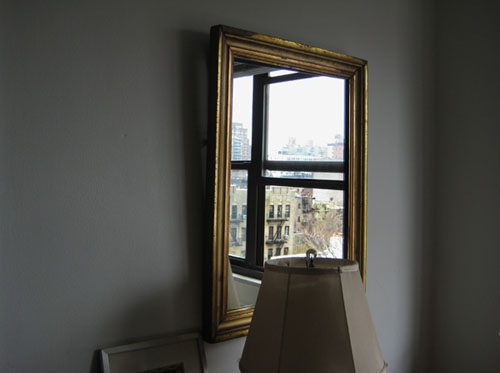
Chelsea: Ashbery's memories of his imaginings of NYC literary life are reflected in the apartment where he now resides. Reflection of west-facing view. Photo by Ahndraya Parlato.
I pressed Ashbery recently to recall details of what he knew as a child about a relative’s life in New York. Elizabeth Sherwood, daughter of his mother’s cousin Olive (who was the daughter of Henry Lawrence’s half-sister Matie Gordon) had married Frederick Rinehart. His mother was the best-selling author Mary Roberts Rinehart, who lived in style in a big apartment house on Fifth Avenue and had helped her two sons establish the publishing house Farrar & Rinehart (John would see Elizabeth and Frederick occasionally after he moved to New York). As Ashbery described it in John Ashbery in Conversation with Mark Ford,1 his first poem, “The Battle,” written when he was eight and, he thinks, possibly influenced by the 1935 movie of A Midsummer Night’s Dream, with Mickey Rooney as Puck (“I remember boning up on Lamb’s version [of Shakespeare, for children] before seeing this movie”), was “on Christmas Day, so the story goes, . . . read aloud in [Rinehart’s] apartment to great acclaim. Alas, I wasn’t there, and in fact didn’t get to New York City until I was seventeen years old.” I had long suspected that memories of what Ashbery imagined as that site of his first New York triumph—a modern, sophisticated, literary setting—have stayed with him, and that there is something of those memories reflected in the building where he has lived since 1972. And then Ashbery told me that there is (somewhere) an unfinished poem, which he wrote around the same time as “The Battle,” about city apartment living!
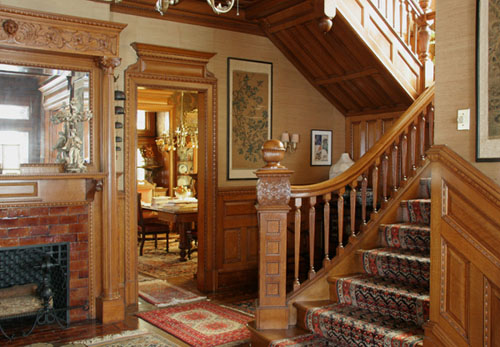
Hudson: An overall sense of the kinetic predominates, an awareness of imminent nextness. Front hall and dining room. Photo by Ahndraya Parlato.
With regard to Ashbery’s Created Spaces, the concept of memory in relation to time offers many intriguing possibilities. For example, in terms of past, present, and future, the house might represent memories of the past as experienced in the present, with hints of the future (the spatial experience of being pulled through the spaces by the light, which moves one forward in real time, or even contemplating future rearrangements of objects that could produce different effects upon the observer); the apartment might represent an idea of the future, experienced in the present, but reassuringly anchored in the past (e.g. by some of its furnishings, but also the idea of this kind of New York apartment that is rooted in a childhood memory). This relationship of memory and time seems to be particularly cinematic.
II. A Cinematic Sensibility (and Memory)
John Ashbery’s poetry is often associated with the visual arts (particularly Abstract Expressionist painting) and music, and he frequently describes his own poetic intentions as being musical. However, one art form which his creative work in all genres touches on is cinema, which now seems to be getting attention from students of Ashbery’s work (though in the 1970s, both John Malcolm Brinnin and David Shapiro pointed to the influence of cinematic techniques on Ashbery’s creative process, and there may have been earlier instances as well). Curiously, Ashbery often mentions Elliott Carter as one of his favorite contemporary composers, and claims Carter’s Duo for Violin and Piano as the inspiration for Ashbery’s split-screen poem “Litany,”2 yet I was surprised to hear Carter recently, in one of the many interviews being aired on the occasion of his centennial, state that one of his chief influences is film.
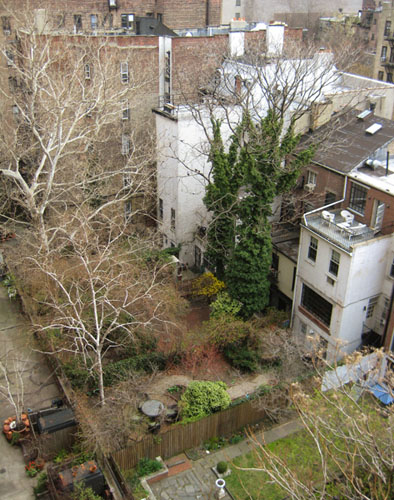
Chelsea Multiplex, Theater 1: East-facing view. Photo by Ahndraya Parlato.
Film has been one of Ashbery’s deepest lifelong interests, ever since he saw his first movie (Disney’s The Three Little Pigs) in 1933, at the age of five, with his grandmother (as described in his poem “The Lonedale Operator”3). Understandably then, film has also been one of the most pervasive influences on his work, in ways ranging from the literal use of movie subject matter and references to the appropriation of technical processes. Memory is a key ingredient in this mix: film in memory, film and memory, film as memory. And because film may be the art form that can come closest to mirroring the way the human mind works, which itself is one of the primary concerns of Ashbery’s work, an understanding of Ashbery’s relationship with cinema is likely to be productive. Like many aspects of this Created Spaces project, the intricacies of this large and complex subject can only be hinted at here; perhaps some essential background information can be most efficiently suggested via excerpts from recent correspondence that I’ve had with film historian Scott MacDonald and with Haden Guest, Director of the Harvard Film Archive, both of whom have expressed interest in this topic.
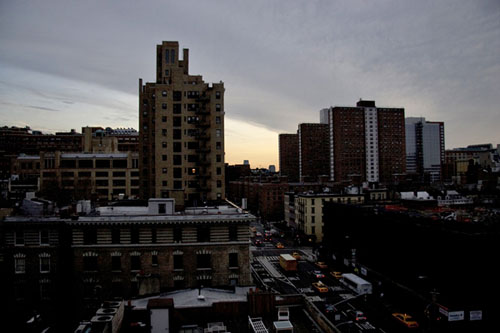
Chelsea Multiplex, Theater 2: South-facing view. Photo by Ahndraya Parlato.
Email from David Kermani to Scott MacDonald, September 25, 2007:
John, born in 1927, is the grandson of the founding chairman of the physics department at the University of Rochester, Henry Lawrence, who was an important figure in the development of x-rays (a form of imaging) and was a friend and neighbor of George Eastman. John spent much of his childhood with his grandparents, and started going to movies at an early age (and he remembers them vividly). It seems to me that growing up in an atmosphere of cutting-edge technological breakthroughs in imaging, with film an integral part of everyday life, must have had a significant effect on a curious, precocious child. (I myself had not realized until a recent visit to Eastman House how personally involved George Eastman had been in the development of the film “industry.”) Add to that JA’s early fascination with Surrealism (sparked in particular by [Alfred Barr’s] 1936 show at MoMA [“Fantastic Art, Dada, and Surrealism”]), and strong interests from childhood in music, theater, and poetry, and he’s a walking case history of someone thoroughly shaped by cinematic process and culture. By the time he was a student at Harvard in the mid-1940s, he was going to Boston film club events; he remembers that Rudy Burckhardt’s 1950 film Mounting Tension4 (in which he had a major role) was shown at Cinema 16 in NYC; his own 1955 play The Compromise, or Queen of Caribou5 was a spoof of early silent films; when he was in Paris from the mid-1950s to the mid-1960s, Elliot Stein [now a noted film historian] introduced him to the film culture there, and he eventually became good friends with Richard Roud [film critic and a co-founder of the New York Film Festival], etc. All of this must have had a profound impact on his poetry during that period.
I suspect that JA thinks . . .[and] creates his environments (both physical and literary), in cinematic terms, in important ways that have yet to be noticed and explicated. The three examples you discuss . . . explore issues of poetry into film, and I think the reverse process—film into the processes and structures of poetry and daily life—could be equally fascinating. The trick would be to find someone conversant enough with both fields to be able to pull it off with credibility (if you know of grad students looking for dissertation topics . . .).
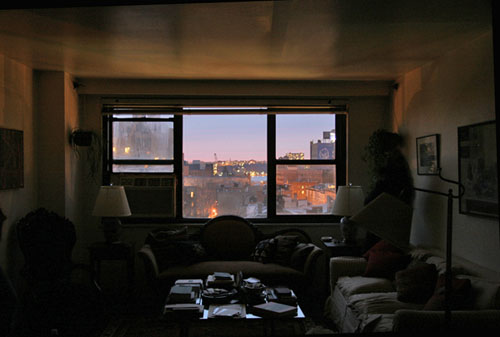
Chelsea Multiplex, Theater 3: West-facing view. Photo by Ahndraya Parlato.
Email from David Kermani to Haden Guest, April 9, 2008:
There’s lots of information about [aspects of JA’s relationship with cinema] in my original bibliography of JA’s work6, as well as in the extension (in progress) of that work that’s online at our Flow Chart/ARC website. There is his writing about theater and film, and lots of material in interviews about these subjects (see the “Influences and Interests” section of the website); his use of cinema as subject and cinematic conventions in his work (e.g. his play[s] The Compromise [and The Philosopher ]). There are the literal references to specific films and film history throughout his work (including his critical writings); also the use of technical film terminology, much of which involves process (many see the impact of cinematic process as a major component of JA’s creative process as well). Then there are his own performances in plays and films (including his recent involvement with Guy Maddin8) as well as the various works that incorporate him as [the character] “John Ashbery,” and also those works that explore or make use of his work (e.g. Caveh Zahedi’s film In the Bathtub of the World9) as part of the concept of the film. And then the miscellaneous stuff—for example, his fascination with [the 1980s TV series] Mad Movies, and the family background in “imaging”—this all reveals that the cinema is as . . . [essential] a part of his environment as the air he breathes.
Email from David Kermani to Haden Guest, March 21, 2008:
In addition, John’s autobiographical prose poem “The Lonedale Operator” (from A Wave, and included in Selected Poems), will give you additional insight into JA’s lifelong and pervasive relationship with film, as will various more recent comments in the Guy Maddin–JA conversations (in various interviews, findable through Google; some should start to be listed soon in the online catalogue of our Ashbery Resource Center . . .). And John Malcolm Brinnin’s review of Self-Portrait in a Convex Mirror in the New York Times10 (back in 1975, although I’m not sure whether he was the first to notice this) specifically notes the powerful influence of cinematic process in those poems.
III. Cinematic Spaces
There are many different, and important, ways in which to consider the nature and significance of Ashbery’s Created Spaces. Like his poetry, they can amply support multiple (and not necessarily mutually exclusive) interpretations, but I think that one of the more useful and comprehensive approaches (perhaps even the most basic) to this subject is the cinematic. Webster’s Third New International Dictionary includes these words as part of its definition of “cinematic:” “having essential technical and aesthetic qualities of motion-picture art (as episodic composition, sustained movement, pictorial brilliance, suspense, the spotlighting of dramatic moments).” One could easily argue that these and other cinematic techniques are abundant in Ashbery’s poetry, and I will not bother to do so here. That a similar array of cinematic characteristics may be discovered in Ashbery’s Created Spaces is not surprising, since they are deeply embedded in many of the most memorable parts of his own life.
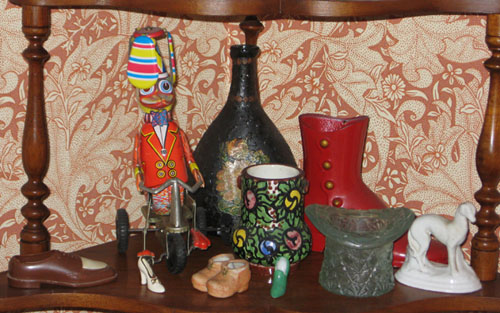
Hudson: One could easily be in the movies, with sets in different styles or prop rooms full of accessories for upcoming productions. Upstairs sitting room. Photo by Ahndraya Parlato.
Ashbery’s cinematic sensibility has, I believe, decidedly influenced his choice of places to live and work, and he has picked spaces that reflect and reinforce these affinities, ones allowing for their fullest play and realization of a broad range of possibilities. His goal has not been to “decorate” these places. Instead, they represent the ongoing process, itself cinematic in nature, of the making and re-making, the imagining and re-imagining of places. Just as Ashbery’s poems encourage multiple readings and interpretations, seeming new each time they are encountered, so his Created Spaces have the capacity to regenerate and present themselves as new, uninterpreted spaces ready to be explored again, sparking fresh sensations each time they are encountered. Visitors have often reported this kind of experience, especially with regard to the house, which is dramatic and solemn, while the apartment is more subtle.
The apartment and house, although very different, are closely related in profound ways; they are symbiotic, two sides of the same coin in terms of what they represent and the effect that they have on Ashbery. The subject is too complex to be dealt with in any detail here, but there are a few basic considerations to keep in mind. First, both are capacious enough to be more than merely functional living spaces, and designed so that the square footage and equipment needed for pragmatic domestic living aren’t dominant (they’re not necessarily hidden away either, but those needs are dealt with in ways that allow the spaces to be experienced in different ways and on multiple levels as well). Even the inevitable household clutter doesn’t overwhelm a strong sense of the basic underlying structure and the anticipation of adventure or discovery.
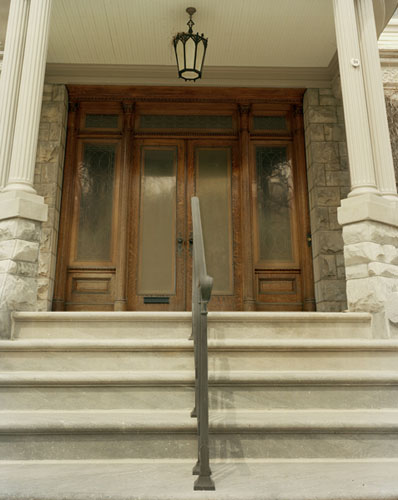
Hudson: The entrance to the house reinforces the sense of leaving behind the outside world. Front porch. Photo by Ahndraya Parlato.
Furthermore, both apartment and house actually possess those characteristic qualities of the cinematic experience: They offer the experience of unusually strong “episodic composition,” which encourages “sustained movement” within the space itself, as well as within oneself, and indeed into various other worlds, through techniques of “pictorial brilliance” (amply shown in the photographs), “suspense” (what’s coming next?), and “the spotlighting of dramatic moments” (see photos). Because both spaces allow one a range of experiences in quick succession, an overall sense of the “kinetic” predominates, an awareness of the imminent nextness of the situation.
Like Ashbery’s poems, these spaces don’t lend themselves to facile interpretation; they are meaningful without having a clearly defined meaning. Many critics point out that Ashbery’s poems require the participation of the reader to complete them, meaning that the reader contributes personal associations in response to the stimulus provided by his words. Ashbery’s Created Spaces function in the same way. The objects that populate them certainly are not intended to limit the experience by guiding one’s thoughts in any particular direction (Ashbery acknowledges no intent beyond making agreeable places in which to live and work), but instead to suggest multiple creative possibilities to the observer, marking different paths within these real and imagined settings. Ashbery has often remarked that his poetry is shaped by what Walter Pater called “the condition of music,” because music is able to communicate powerfully without the inherent limitations of words; perhaps Ashbery’s Created Spaces are more fully realized poetic constructions than his poems because they do not rely on words to convey their messages.
At some point it may be possible to offer a virtual tour of Ashbery’s environments, but Ahndraya Parlato’s extraordinary photos and Archie Rand’s evocative and decidedly cinematic paintings of the interior of the house (his own film noir), give a sense of the “sustained movement” that drives the experience. (Rand said he was trying to paint the atmosphere around the objects, the mysterious, quasi-animate surround rather than the static thing.) I’ll try to augment these visuals with a brief sketch of a few of the cinematic aspects of each space.

Hudson: The unexpected frustrates one's basic assumptions. Music room. Photo by Ahndraya Parlato.
Being in the apartment is like being at the movies, perhaps in a multiplex where you might be aware of several different films being shown simultaneously. One enters through a narrow, dark, ten-foot-long hallway, drawn forward by light coming through wide windows ahead to the right, in the west walls of the living room and study, drawn around and through the space by expansive windows that afford views (and light) from the east, south, and west. But the views are of three very different New Yorks: to the east are the terraces and gardens behind the mid-nineteenth-century townhouses; to the south is a densely packed array of different types of buildings penetrated by Ninth Avenue like an arrow; to the west, an intriguing vista over and between buildings to the Hudson River and New Jersey, and broad skies, with the activities of boats, planes, and trains. These scenes are frequently very dramatic, especially sunrises and sunsets, and in times of wild weather it is even possible to witness different weather systems by looking to the west (from where most of them approach) and east (so sheltered by the height and L-shape of the building itself that the trees in the gardens below may not even be stirring in the wind).
As was pointed out to me by Jonathan Boyd, sitting in Ashbery’s favorite chair, which is low and faces a wall of windows, is like being a child again, in the front row at a movie theater gazing up at the big screen. The ongoing spectacle viewed through the west windows is enhanced when one looks to the left and right, where one sees on the two windowless walls paintings by Jane Freilicher that include windows, one looking out to another city view, and the other into dark night. This is the same kind of experience that can be had at Frederic Church’s Olana, that radical, proto-cinematic work of art (near the house in Hudson) that Archie Rand describes as the same type of artistic creation as an Ashbery poem.
Even the space in Ashbery’s quintessential New York apartment has a cinematic quality. Although many apartments of the period are bland white cubes, the structural skeleton of the building is reflected in the interior of this one. For me, the play of light and shadow created by the beams as they intersect with columns and walls can evoke unspecific but vaguely unsettling feelings akin to film noir, while at other times these same elements have a purely abstract beauty.
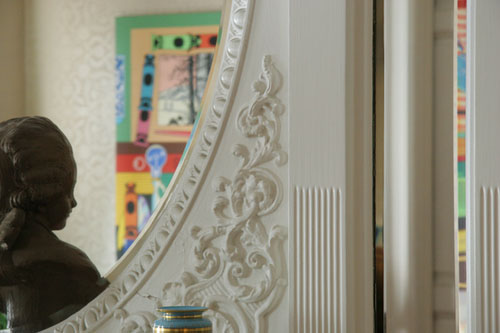
Hudson: The fragmentation of the spatial experience. Music room. Photo by Ahndraya Parlato.
The house is very different from the apartment in many important respects. It provides a strong cinematic experience as well, but instead of feeling that one is at the movies, one could easily be in the movies, or more precisely in the process of making movies, on a studio lot with sets in different styles, where various scenarios can unfold, or in prop rooms where you can select accessories for an upcoming production. As in the apartment, the light draws one through the space, a process enhanced by multiple mirrors which serve to place directly in front of you a reflection of the space that you just passed through.
Entrance to the house is a progression through a series of spaces (stairs, porch, vestibule, hall) that reinforce the sense of leaving behind the outside world (a major component of the apartment) and entering a private, interior world. The well-populated rooms that invite discovery are quite different from the simple space of the apartment. The simultaneous fluidity and fragmented nature of the spatial experience (largely a result of light and mirrors with wide beveled edges) is intensified by the way in which the unexpected frustrates one’s basic assumptions (in typical Ashbery fashion): for example, the presence in a formally furnished, French-style room of a large painting depicting the aftermath of a restaurant brawl, or the large stained glass window which dominates the open staircase and central hall but is hidden from view until one is directly opposite it.
The upper and lower halls are papered in neutral grasscloth above the wainscoting, but the rooms that open off these spaces are done in bold florals or curvilinear designs, some subtle and others dramatic, and each room promises a distinct experience. On the first floor, architectural detailing predominates. Upstairs, the rooms are simpler, but from the upper hall, dominated by the huge stairwell window and eight doorways, the rooms seem like private bowers, leafy and sheltering, each with a different atmosphere but, because each is furnished to accommodate multiple activities, one can listen to music or read in the office, or write checks at a desk in a bedroom. The artworks on the walls take on particularly cinematic qualities, depending on how they are framed and on lighting conditions. Some seem to come into focus only when one looks directly at them, otherwise being subsumed into the patterned papers behind them; others seem spotlit all the time; while still others will emerge occasionally in sharp clarity and then dissolve from awareness depending on what else is being looked at.
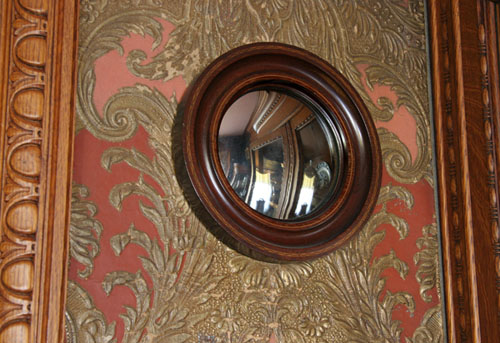
Hudson: The fluidity of the spatial experience. Music room. Photo by Ahndraya Parlato.
I could go on and on—even the long process of finding the house was like scouting for a movie location. And according to the architect’s specs for the house, which spell out every last structural detail, the only thing said about the impressive interiors was that they were to be “supplied by owner”—i.e., selected and purchased from catalogues, shipped by rail or boat, and then installed within the exterior shell of the house like a stage set.
Ashbery chose both the apartment and house because he sensed that they had the potential to become important tools, serving to enhance his creativity and supply much of the raw material for his work. Ashbery’s Created Spaces are indeed his personal Cinema Paradiso.
1John Ashbery in Conversation with Mark Ford (London: BTL, 2003).
2As We Know (New York: Viking, 1979), pp. 3-68.
3A Wave (New York: Viking, 1984), pp. 48-49.
4New York: Grove Press, 1950.
5Three Plays (Calais, VT: Z Press, 1978), pp. 31-119.
6John Ashbery: A Comprehensive Bibliography (New York: Garland, 1976).
7Three Plays (Calais, VT: Z Press, 1978), pp. 121-160.
8Ashbery was one of several celebrities, including Isabella Rossellini, Crispin Glover, Lou Reed, and Laurie Anderson, to play the role of “the Interlocutor,” providing live narration for Guy Maddin’s film Brand upon the Brain! Ashbery’s performance took play May 13 at the Village East Theater, New York City. Information on other aspects of the collaborative relationship between Ashbery and Maddin is available in Jessica Winter’s interview with Maddin, “’Plenty of Subliminated Rin Tin Tin,’” at the Poetry Foundation website.
9World Artists, 2001.
10“The Deliberate Lies Down with the Random,” New York Times Book Review (August 10, 1975), pp. 7-8.
